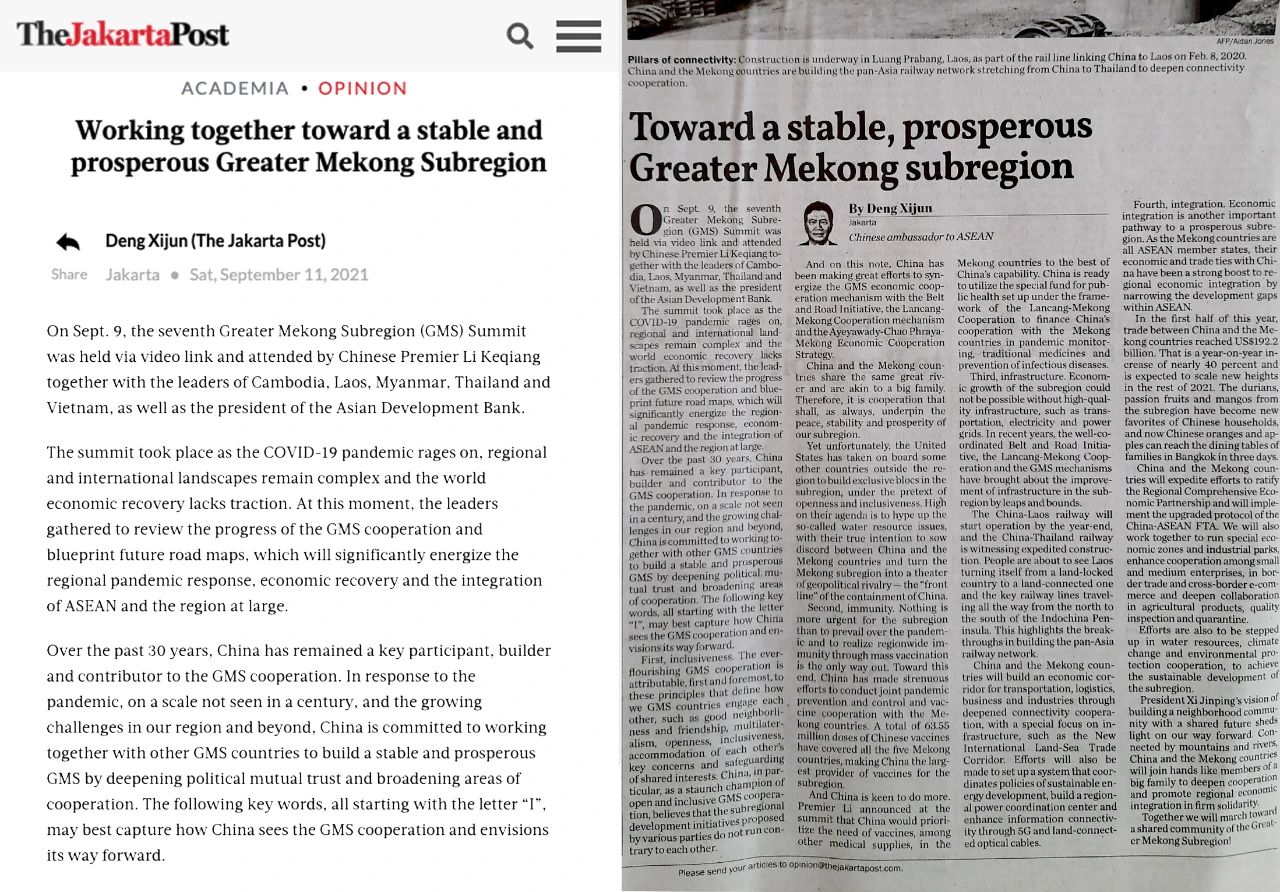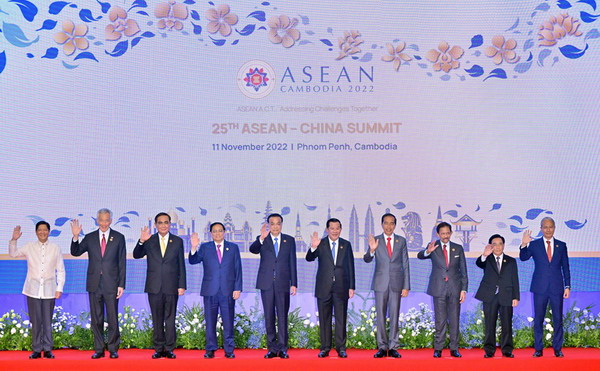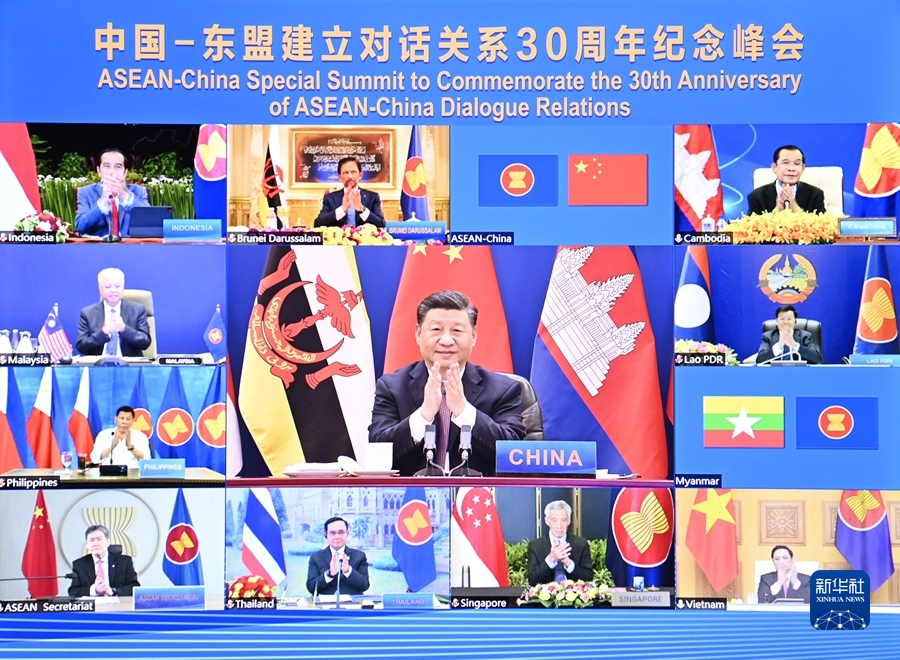|

On September 9, the 7th Greater Mekong Subregion (GMS) Summit was held via video link and attended by Chinese Premier Li Keqiang together with leaders of Cambodia, the Lao PDR, Myanmar, Thailand and Vietnam as well as President of the Asian Development Bank.
The Summit took place while the COVID-19 pandemic rages on, regional and international landscape remains complex and the world economic recovery lacks traction. At this moment, the leaders gathered to review progress of GMS cooperation and blueprint future roadmaps, which will significantly energize regional pandemic response, economic recovery and the integration of ASEAN and the region at large.
Over the past 30 years, China has remained as a key participant, builder and contributor to GMS cooperation. In response to the pandemic unseen in a century and the growing challenges in our region and beyond, China is committed to working together with other GMS countries to build a stable and prosperous Greater Mekong Subregion by deepening political mutual trust and broadening areas of cooperation. The following key words, all starting with the letter “I”, may best capture how China sees the GMS cooperation and envisions its way forward.
First, inclusiveness. The ever-flourishing GMS cooperation is attributable, first and foremost, to these principles that define how we GMS countries engage each other, such as good neighborliness and friendship, multilateralism, openness, inclusiveness, accommodation of each other’s key concerns and safeguarding of shared interests. China, in particular, as a staunch champion of open and inclusive GMS cooperation, believes that the subregional development initiatives proposed by various parties don’t run contrary to each other. And on this note, China has been making great efforts to synergize the GMS economic cooperation mechanism with the Belt and Road Initiative, the Lancang-Mekong Cooperation mechanism and the Ayeyawady-Chao Phraya-Mekong Economic Cooperation Strategy.
China and the Mekong countries share the same great river and are akin to a big family. Therefore, it is cooperation that shall and has always underpinned the peace, stability and prosperity of our subregion. Yet unfortunately, the United States has taken on board some other countries outside the region to build exclusive blocs in the subregion under the pretext of openness and inclusiveness. High on their agenda is to hype up the so-called water resource issues from time to time, with their true intention to sow discords between China and the Mekong countries and turn the Mekong subregion into a theater of geopolitical rivalry and the “front line” of containment of China. These attempts have only found themselves unpopular with and unacceptable to the GMS countries and thus are doomed to failure.
Second, immunity. Nothing is more urgent for the subregion than to prevail over the pandemic, and to realize regionwide immunity through mass vaccination is the only way out. Toward this end, China has made strenuous efforts to conduct joint pandemic prevention and control and vaccine cooperation with the Mekong countries. Chinese vaccines have covered all the five Mekong countries, making China the largest provider of vaccines for the subregion.
And China is keen to do more. Premier Li Keqiang announced at the Summit that China will prioritize the need of vaccines, among other medical supplies, of the Mekong countries to the best of China’s capability. And China is ready to utilize the special fund on public health set up under the framework of the Lancang-Mekong Cooperation to finance China’s cooperation with the Mekong countries in pandemic monitoring, traditional medicines and prevention of infectious diseases.
Third, infrastructure. Economic growth of the subregion couldn’t be possible without high-quality infrastructure, such as transport, electricity and power grid. In recent years, the well-coordinated Belt and Road Initiative, the Lancang-Mekong Cooperation and the GMS mechanisms have brought about improvement of infrastructure in the subregion by leaps and bounds. The China-Laos railway will start operation by the year-end, and the China-Thailand railway is witnessing expedited construction. People are about to see the Lao PDR turning itself from a land-locked country to a land-connected one and the key railway lines making all their way from the north to the south of the Indochina Peninsular. That would well imply breakthroughs in building the Pan-Asia railway network.
China and the Mekong countries will build an economic corridor featuring transport, logistics, business and industries through deepened connectivity cooperation, with a special focus on infrastructure, such as the New International Land-Sea Trade Corridor. Efforts will also be made to set up a system that coordinates policies of sustainable energy development, build a regional power coordination center and enhance information connectivity through 5G and land-connected optical cables.
Fourth, integration. Economic integration is another important pathway to a prosperous subregion. As the Mekong countries are all ASEAN Member States, their economic and trade ties with China have been a strong boost to regional economic integration by narrowing the development gaps within ASEAN.
In the first half of this year, trade between China and the Mekong countries reached 192.2 billion US dollars. That is a year-on-year increase of nearly 40 percent and is expected to scale new heights in the rest of 2021. The durians, passion fruits and mangos from the subregion have become new favorites of Chinese households, and now Chinese oranges and apples could reach the dining tables of families in Bangkok in three days.
China and the Mekong countries will expedite efforts to ratify the Regional Comprehensive Economic Partnership and well implement the upgraded protocol of China-ASEAN FTA. We will also work together to run Special Economic Zones and industrial parks, enhance cooperation among SMEs, in border trade and cross-border e-commerce, and deepen collaboration in agricultural products, quality inspection and quarantine. Efforts are also to be stepped up in water resource, climate change and environmental protection cooperation, with a view to achieve sustainable development of the subregion.
President Xi Jinping’s vision of building a neighborhood community with a shared future sheds light on our way forward. Connected by mountains and rivers, China and the Mekong countries will join hands like members of a big family to deepen cooperation and promote regional economic integration in firm solidarity. Together we will be marching toward a shared community of the Greater Mekong Subregion!
|











